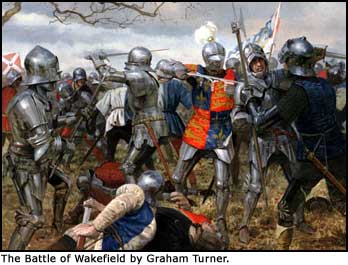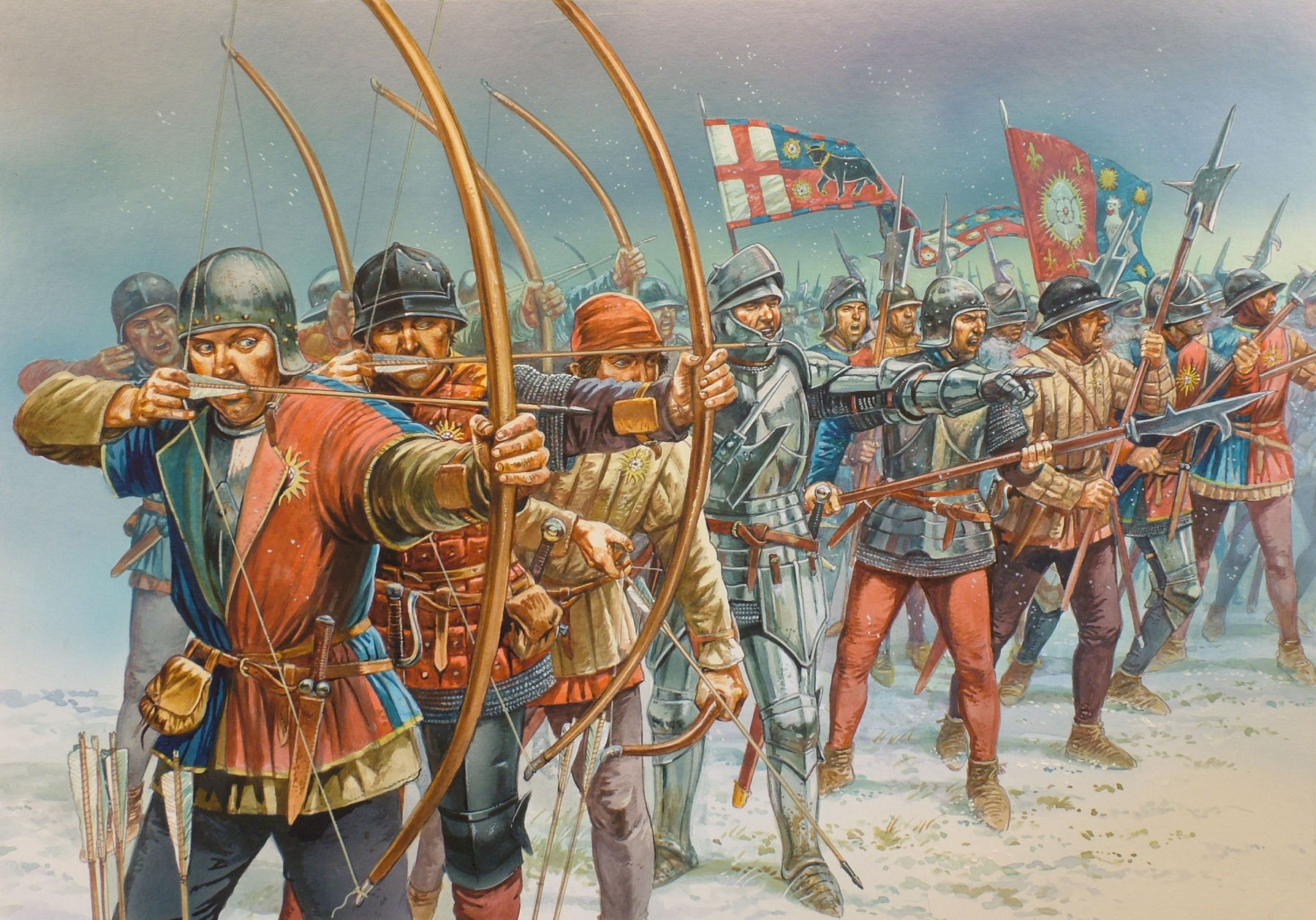The wars raged across 15th Century England made it essential for forces to be properly armed and protected.
ARMOUR
Men-at-arms in the thick of the action were fitted with heavy armour with a breast-plate underneath a leather brigandine or chain-mail hauberk. Attached to the breastplate were the plate armoured gorget around the neck, pauldron over the shoulders, couter over the elbows, vambraces over the forearms, tassets over the thighs and culet over the lower back. Added protection was found with plate-armoured gauntlet gloves and knights wore lance rests attached to the breast plate to steady their lances for a firmer blow.
 |
| Horses were also glad in plate armour |
The main disadvantage of heavy armour was the lack of mobility and the quick-moving infantry wore a mail shirt over a padded aketonmail, with added munitions plate covering the most important body parts. Light armour mostly consisted of padded cloth and leather with the archer's bracer providing a leather armguard to protect the fletching of an arrow.
 |
| A Richard III re-enactor wears a crowed sallet helmet |
Helmets also varied in design depending on how much protection was needed. Heavy helmets were made from steel plate, covered the head with visors on bascinets, armets, sallets and close helmets. Richard III was likely wearing a crowned sallet when he charged Henry Tudor at the Battle of Bosworth.
Medium helmets were made of steel, but didn't protect the entire head like the visor-less barbute helmet. Light helmets were usually caps made of cloth and leather but archers preferred the wide-brimmed steel kettle hats for greater field of vision and to shield their eyes from the sun. Helmets were often customised with different colours, plumes, coifs and bevors.
 |
| Archers wore kettle helmets to shield their eyes from the sun |
COMBAT WEAPONS
The advancements in protective armour led to the development of the longsword which allowed a double-handed grip with the sword's longer hilt. The finest swords of the era were stamped with a German Passau wolf and the unusually hard Toledo steel forged in Spain. Daggers were often used as a side-arm and the small, sharp bladed wound on top of Richard III's skull showed that they were used as execution weapons, with two hands likely used to push the pommel into Richard III's skull.
Other weapons used by men-at-arms included hammers, maces, axes, spears and pole arms like the halberd. The halberd was inexpensive to produce and very versatile in battle as the hook and axe head were able to pull horsemen to the ground. The large hole at the base of Richard III's skull shows that a halberd likely sliced the back of the king's head and struck the fatal blow. The bill hook was also effective at bringing down a horseman with the pronounced hook able to find a chink in the knight's armour.
 |
| A halberd likely struck the fatal blow to Richard III |
Men on horseback attacked in triangular formations, with the most heavily armored knights at the front. They defended themselves with shields and attacked with a wooden lance that would shatter upon impact. Richard III was the head of a triangular formation charging towards Henry Tudor and his lance shattered into the helmet of Tudor's standard bearer, Sir William Brandon.
RANGED WEAPONS
The longbow gained it's notoriety at the Battle of Agincourt with a fast reload, accurate archers, armour-piercing bodkin heads and light-weight bowstaves. Compulsory longbow training was enforced in 1470 and many of the fragile yew bowstaves would often break and needed replacing. This led to a shortage in yew and this was overcome by Richard III increasing the tax on ships arriving in English ports to 10 bowstaves per tun in cargo, up from 4 bowstaves decreed in the Statue of Westminster 1472.
 |
| Longbowmen in action at the Battle of Towton (Graham Turner) |
 |
| Cannon fires at a Battle of Tewkesbury festival |
TACTICS
In the early 1450s the act of gathering troops and marching to battle didn't usually result in combat as Duke of York's standoff at Dartford showed. Henry VI may have been expecting the same when he garrisoned the wall-less town of St. Albans in 1455 but York decided to end hours of stalemate by launching the First Battle of St. Albans.A commander would line his troops into three 'battles' - the vanguard leading the attack, the main in the middle, and the rearguard often holding back reserves. Archers had previously launched the opening salvo into opposing infantry but by the mid-1400s this had developed into a stalemate of opposing bowmen fighting each other. Men-at-arms would either lead the vanguard on foot (Battle of Northampton) or on horseback (Battle of Blore Heath).
 |
| Lord Audley leads a cavalry charge at Blore Heath |
The rank-and-file troops were gathered by their lords or knights and served in all of their disputes wearing the lord's ‘livery’ and fought under their banner. In return, the lord ‘maintained’ their tenants' rights and claims. This ‘livery and maintenance’ soon developed into ‘bastard feudalism’ as cash rewards replaced traditional land gains.
The level of professionalism varied amongst the troops who would often flee the battlefield or surrender unarmed when the fight was lost. The Wars of the Roses was mainly a dispute between noble families and the rank-and-file were spared the bloodshed of their noble commanders whose heavy armour would hinder them escaping a melee.
 |
| Battle of Wakefield saw the end of chivalric ransoms |
The other escapee of Ludford was York's eldest son, Edward, who would claim the throne in 1461 after fighting amongst 50,000 men at the Battle of Towton that left 26,000 dead. Richard III would also charge into battle and refused to withdraw from the Battle of Bosworth after he was dismounted. Bosworth would ultimately be decided by those fighting under livery and maintenance as Sir William Stanley led his men at the crucial moment to attack the king.
The 30 years between the First Battle of St. Albans and Bosworth had periods of uneasy rest but the brutal battles and the twisted machinations would ensure that blood would soon be spilt and the long vaunted days of chivalry were over

This is so helpful! Thank you!
ReplyDelete0w0 it was intresting
ReplyDeleteh
ReplyDeletehi
ReplyDeleteThere,
Thank you for sharing a knowledgeable blog with us I hope that you will post many more blog with us:
The need of Medieval armour in 21st century is figured out in historical events, drama, shows, casting of tv serials, and many other similar occasions. If you’re looking to cast a show where dressing up like a real medieval knight is the need of hours, here is the right suggestion. Indian Medieval armour is an online store of real Medieval armour. We have special Medieval armour for sale Germany discounts for those who want to order them in bulk.
Click here: Medieval Armour For Sale
Ty helped so much
ReplyDelete